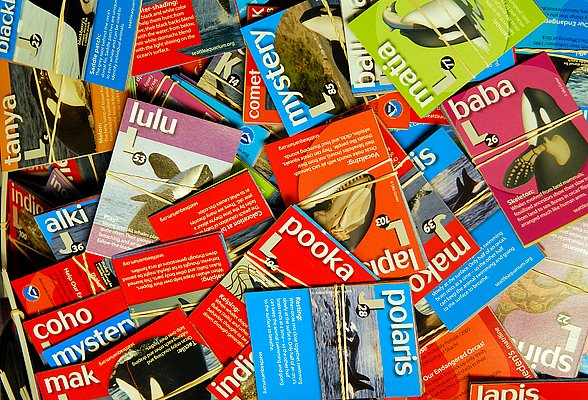Photo taken under NOAA permit

Example Activities
Our program includes several activities for students. The exact activities used depends on available time, age/grade, and group dynamic.
All activities support the Next Generation Science Standards.
Fish and Chips
What are they eating and where is it coming from?
(50mins/3rd-6th grade. In-person and on-line)
In this hands-on activity, students play the role of scientist who collects and analyzes fish scales left over from predation events. Using this data, participants are able to chart and record not only the types of fish the whales are eating, but when they are eating them and where those fish are spawning from! Follow up discussion tackles the necessity of protecting the spawning streams of the regions salmon.
Fish and Chips 2
What are they eating and where is it coming from-The sequel!
(50mins/3rd-6th grade. In-person and on-line)
In this follow up to the original hands-on activity, students play the role of scientist who collects and analyzes fish scales left over from predation events during the Pacific NW winter months.
Using data collected by Dr. Brad Hanson and our colleagues at Northwest Fisheries Science Center/NOAA, we will explore the prey items these whales are eating. Utilizing scientific method/scientific inquiry we will attempt to answer the critical question: what are they eating and where is it coming from? We will test each students’ hypotheses using actual data (yes, that includes poop sample data!) from Dr. Hanson’s groundbreaking work!
Who am I & Where am I Going?
Identification of individual killer whales and mapping of critical habitat
(50mins/All ages. In-person and on-line)
Using photographs collected the previous summer by ourselves and our research partners, The Center for Whale Research, students will learn to identify individual whales. Students will then have the chance to map the locations where the whales were photographed and recording the whales’ use of the Puget Sound habitat.
Say What?
Killer communication and how to be Whale Wise
(30-50mins/All ages. In-person)
In this experiential hands-on activity, students experience what it is like to communicate through sound and only sound. We then brainstorm ways to clean up the whales’ acoustic environment. Students are then asked to formulate ways to protect the regions whales from the negative effects of human created noise.
Drone On!
One of these things is not like the others…
(50mins/All ages. In-person and on-line)
Are drones a good way to study the health and activities of our endangered Southern Resident killer whales? What can we learn about them using this aerial platform? Can we use this data to inform conservation of these endangered animals?
Using data collected by Dr. Holly Fernbach and Dr. John Durban at SR3 (Sealife Response, Rehab and Research), we will explore these questions using scientific method/scientific inquiry. We will test each students’ hypotheses using actual pictures collected from SR3’s groundbreaking work!
Orca Acoustic Game Show
A Killer Whale Tales Science Activity
(30mins/All ages. In-person and on-line)
What do you know about then endangered Southern Resident killer whales? Join us for this game show style educational program and get a chance to earn some fabulous prizes! (And learn about these amazing whales, too!)
The Secret Lives of Killer Whales
Using Dtags to track the underwater behavior of endangered killer whales
(50mins/3rd-6th grade. In-person and on-line)
What do the endangered Southern Resident killer whales (SRKW) do under water? Are they hunting? Sleeping? Travelling? Is their behavior different at night? How deep do they dive? How long can they stay underwater? Using data collected by Dr. Marla Holt and the researchers at Northwest Fisheries Science Center/NOAA, we will use scientific method, create our own hypothesis and test those using actual data collected from a tag stuck to the back of an actual SRKW!
Copyright © 2024 Killer Whale Tales
Site design by Claire Brandt
